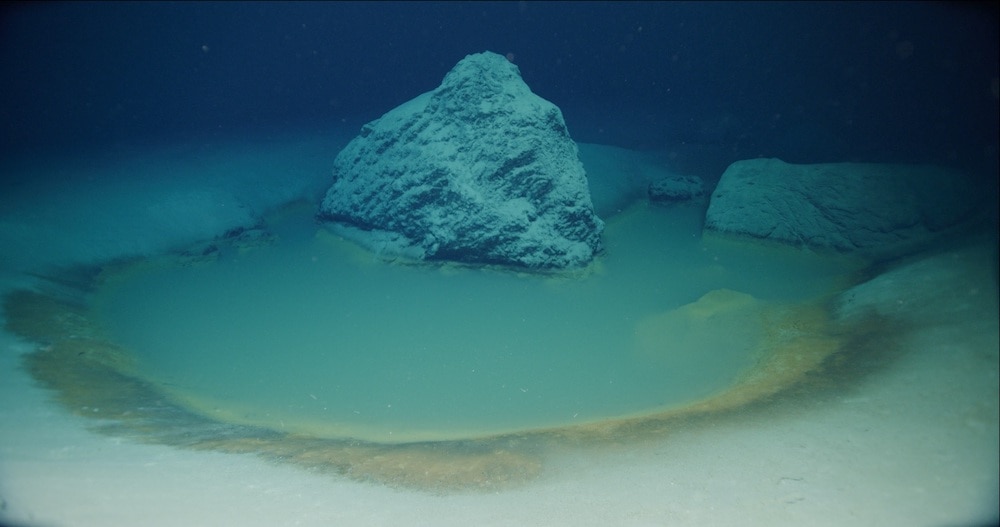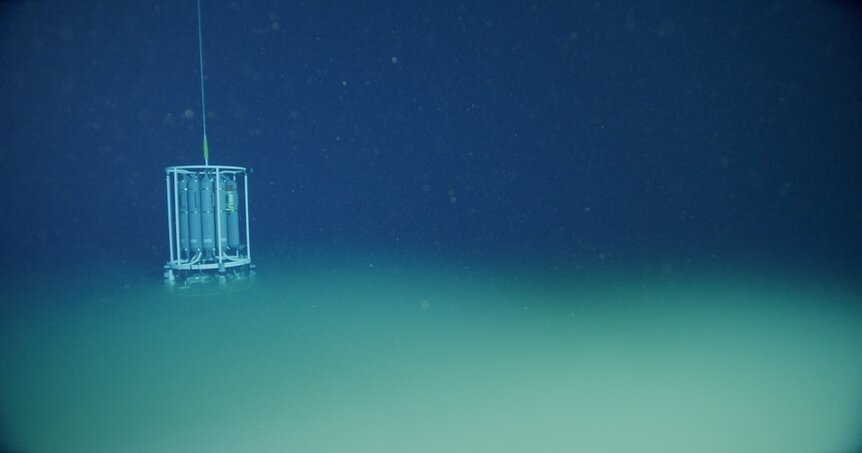Create a free profile to get unlimited access to exclusive videos, sweepstakes, and more!
Deep sea brine pools kill any animal that enters, but could be a window into the origin of life
This is the world's worst hot tub, unless you're an anaerobic bacterium.

In the animated series Weird Waters (now streaming on Peacock!), two fishy friends, BZ and I.M. Tiger, unwittingly find themselves in a magical pond where fish get powers when they reach adulthood. As far as we know, there are no magical ponds or fishy superpowers in the real world, but underwater brine pools do represent some of the world’s weirdest waters, indeed, and they’re certainly magical in their own right. Not only are they instantly fatal to any animal unlucky enough to swim inside their borders, but they might also offer a window into the emergence of life on our planet.
They form at the boundary between fault lines in areas where significant stores of salt are sequestered in the seafloor. The Red Sea is a particularly good place for their formation, owing to its unique geological history and its relative isolation from the world’s oceans. Roughly 10 million years ago, the sea was cut off and dried up leaving a layer of salt which extends several kilometers deep in some locations. Now that the sea has returned, water seeps into the cracks between fault lines, dissolving the salt and dredging it up in a thick sludge so viscous that it settles into pools on the seafloor.
Scientists are interested in brine pools because of the unusual ecosystems they harbor, as discussed in a new study published in the journal Communications Earth & Environment, but finding them can be a challenge. In 2020, Sam Purkis, a scientist from the University of Miami, along with a team of colleagues and in partnership with OceanX, embarked upon an expedition in the Gulf of Aqaba along the northern end of the Red Sea. They were searching for brine pools using a suite of high-tech investigatory tools including a 15,000 pound remotely operated underwater vehicle about the size of a small truck.
“We mapped the seafloor with multibeam, an acoustic technique for making 3D maps from the ship. The brine pools didn’t show up but there was a particularly deep area in the Gulf of Aqaba, nearly two kilometers deep, and I had the idea that this is the sort of area where you may get brine pools,” Purkis told SYFY WIRE.
The area Purkis had identified had the right kind of faulting activity and salt stores which weren’t buried too deeply in the substrate. It ticked the right boxes, but he had to convince the rest of the team to take a chance on his hunch. Operating a ship like the one they were using costs about $600,000 per day — underwater robots aren't cheap — and competition for time and resources is fierce. Moreover, the trip to the seafloor takes about two hours each way. It isn’t a quick jaunt or an easy endeavor, but Purkis succeeded in pleading his case.
“I got my wish, and we launched the ROV. It lands on the bottom and there’s just nothing. It’s a muddy desert, the most boring thing you could imagine,” Purkis said.
Hours went by with the ROV trudging ahead in a featureless underwater landscape. It moved at a slow walking pace while exploring, with the clock ticking away. Because it takes two hours to retrieve the device, there’s a hard stop when they have to pull it up and the deadline was quickly approaching. Even worse, footage from the ROV was streaming to TV monitors all over the ship. Everyone was watching. With about 10 minutes on the clock, just as they were about to give up and pull the ROV back to the ship, something appeared on the horizon.
As the ROV approached the brine pool, its thrusters disturbed the surface, sending slow-moving waves rippling out into the surrounding waters. What was revealed is an underwater oasis built around one of nature’s most efficient death traps.
“A mile deep in the ocean there’s not a lot of life, it’s certainly not biodiverse. That’s why the first eight hours of the dive were so mind-numbingly awful. Suddenly, you come across the brine pool and it’s like an oasis of life. You have these rich microbial mats around the pool and then there are other animals which sort of make their home around the brine,” Purkis said.
Populations of shrimp, fish, and eels set up shop around these pools to catch an easy meal, although ease is a relative term when you consider that every time they dip down to catch prey, they’re taking their lives into their own fins. Any animal who accidentally slips into the pool is stunned from the high salinity and lack of oxygen. There’s no light to speak of, but scientists believe predators and scavengers can sense the vibrations of an animal entering the brine, then they slip down to pick them up before they sink into the pool and are lost forever.
Inside the pools are a vast diversity of hardy microbial life known as extremophiles. They thrive where other life doesn’t dare to tread. Peering inside of those pools at the alien life living there could give us a glimpse into the origins of life in Earth’s distant past.
“From our understanding, life forms on planet Earth a little shy of 4 billion years ago. At that time, there’s no oxygen in the atmosphere and none in the ocean. Probably, life formed in the deep sea in an ancient ocean and probably related to hydrothermal activity. The brine pools are interesting because it’s hydrothermal flow bringing the brine up to the surface. They’re completely devoid of oxygen and you get these rich communities of extreme microbes which are living without oxygen in the deepest depths of the ocean. So, it’s a really compelling analogue to the sort of conditions where you might expect first life on Earth to have formed,” Purkis said.
They could also provide a road map, so to speak, as we search for life off Earth. A destination like Europa, one of Jupiter’s largest moons, is appealing precisely because we believe it to have a large ocean beneath its icy surface and there’s good reason to believe it has geothermal activity. Like the Gulf of Aqaba, it checks many of the right boxes for the emergence of life. Of course, considering how difficult it is to find brine pools on our own planet, finding something similar on a distant moon might be even harder.
In the meantime, these deadly underwater pools are teaching us about how our own story might have begun and the weird ways in which it continues to this day. It’s heartening to know that life finds ways to carry on even in the most hostile environments. We wouldn’t want to live there, but it’s a nice place to visit.



























